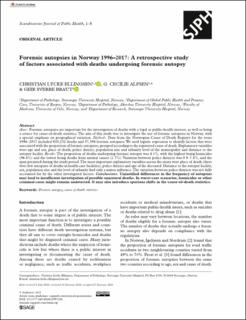| dc.contributor.author | Ellingsen, Christian Lycke | |
| dc.contributor.author | Alfsen, G. Cecilie | |
| dc.contributor.author | Braut, Geir Sverre | |
| dc.date.accessioned | 2022-01-24T08:36:22Z | |
| dc.date.available | 2022-01-24T08:36:22Z | |
| dc.date.created | 2021-06-14T22:41:33Z | |
| dc.date.issued | 2021 | |
| dc.identifier.issn | 1403-4948 | |
| dc.identifier.uri | https://hdl.handle.net/11250/2838849 | |
| dc.description.abstract | Aims:
Forensic autopsies are important for the investigation of deaths with a legal or public-health interest, as well as being a source for cause-of-death statistics. The aim of this study was to investigate the use of forensic autopsies in Norway, with a special emphasis on geographical variation.
Methods:
Data from the Norwegian Cause of Death Registry for the years 1996–2017 included 920,232 deaths and 37,398 forensic autopsies. We used logistic regression to identify factors that were associated with the proportion of forensic autopsies, grouped according to the registered cause of death. Explanatory variables were age and sex, place of death, police district, population size and urbanity level of the municipality and distance to the autopsy facility.
Results:
The proportion of deaths undergoing forensic autopsy was 4.1%, with the highest being homicides (96.6%) and the lowest being deaths from natural causes (1.7%). Variation between police districts was 0.9–7.8%, and the span persisted during the study period. The most important explanatory variables across the strata were place of death (there were few autopsies of deaths in health-care facilities), police district and age of the deceased. Distance to the autopsy facility, sex, population size and the level of urbanity had only a minor influence. The variation between police districts was not fully accounted for by the other investigated factors.
Conclusions:
Unjustified differences in the frequency of autopsies may lead to insufficient investigation of possible unnatural deaths. In worst-case scenarios, homicides or other criminal cases might remain undetected. It may also introduce spurious shifts in the cause-of-death statistics. | en_US |
| dc.language.iso | eng | en_US |
| dc.publisher | SAGE Publications | en_US |
| dc.rights | Navngivelse 4.0 Internasjonal | * |
| dc.rights.uri | http://creativecommons.org/licenses/by/4.0/deed.no | * |
| dc.title | Forensic autopsies in Norway 1996–2017: A retrospective study of factors associated with deaths undergoing forensic autopsy | en_US |
| dc.type | Journal article | en_US |
| dc.type | Peer reviewed | en_US |
| dc.description.version | publishedVersion | en_US |
| dc.rights.holder | Copyright Author(s) 2021 | en_US |
| cristin.ispublished | true | |
| cristin.fulltext | original | |
| cristin.qualitycode | 1 | |
| dc.identifier.doi | 10.1177/1403494821997208 | |
| dc.identifier.cristin | 1915758 | |
| dc.source.journal | Scandinavian Journal of Public Health | en_US |
| dc.identifier.citation | Scandinavian Journal of Public Health, 2021. | en_US |

